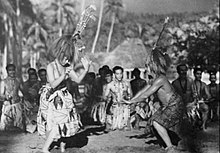Moana (1926 film)
| Moana | |
|---|---|

Wedding of Moana
|
|
| Directed by | Robert J. Flaherty |
| Produced by | Robert J. Flaherty |
| Written by | Robert J. Flaherty |
| Starring | Fa'agase Su'a-Filo Pe'a Ta'avale Tugaita |
| Cinematography | Robert J. Flaherty |
| Edited by | Robert J. Flaherty |
| Distributed by | Paramount Pictures |
|
Release date
|
|
|
Running time
|
85 minutes; 7 reels at 6,133 feet |
| Country | United States |
Moana (pronounced [ˈmo.ana]) is a 1926 American documentary film, or more strictly a work of docufiction, that was directed by Robert J. Flaherty, the creator of Nanook of the North (1922).
Moana was filmed in Samoa in the villages of Safune district on the island of Savai'i. The name of the lead male character, moana, means "deep water" in the Samoan language. In making the film, Flaherty lived with his wife and collaborator Frances and their three daughters in Samoa for more than a year. Flaherty arrived in Samoa in April 1923 and stayed until December 1924, with the film being completed in December 1925.
Hoping that Flaherty could repeat the success of Nanook, Paramount Pictures sent him to Samoa to capture the traditional life of the Polynesians on film. Flaherty reportedly arrived with 16 tons of filmmaking equipment. This included both a regular movie camera and a Prizma color camera, as Flaherty hoped to film some footage in that color process, but the Prizmacolor camera malfunctioned.
Moana is thought to be the first feature film made with panchromatic black-and-white film rather than the orthochromatic film commonly used at the time in Hollywood feature films. Flaherty developed his film as he went along, in a cave on Savai'i. In the process, he inadvertently poisoned himself and required treatment after he drank water from the cave that contained silver nitrate, which washed off the film stock. The silver nitrate also caused spots to form on the negative.
As in the earlier Nanook (and his later film, Man of Aran), Flaherty went well beyond recording the life of the people of Samoa as it happened. He followed his usual procedure of "casting" locals whom he considered potentially photogenic performers into "roles", including creating fictitious family relationships.
...
Wikipedia
